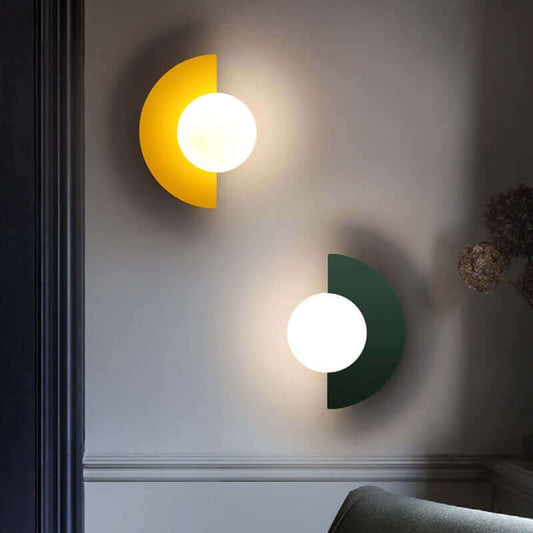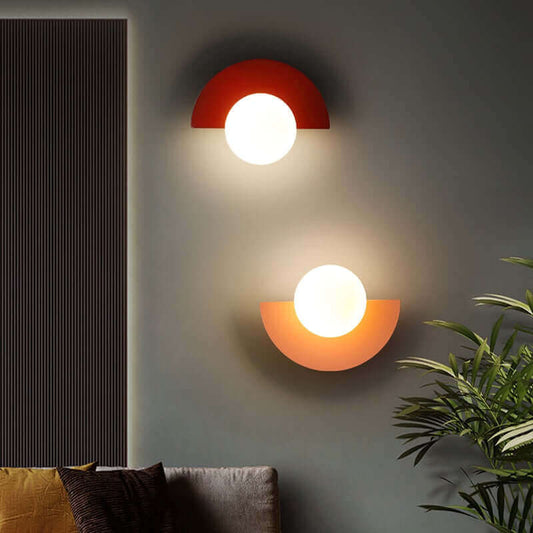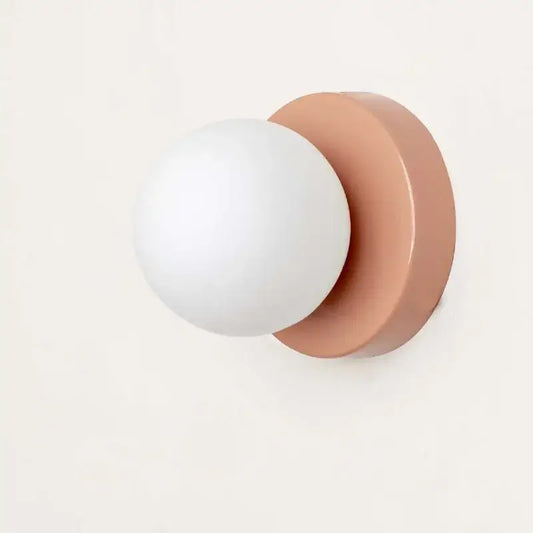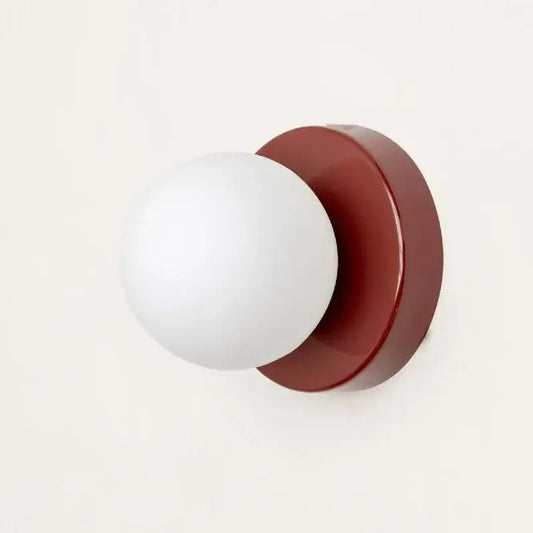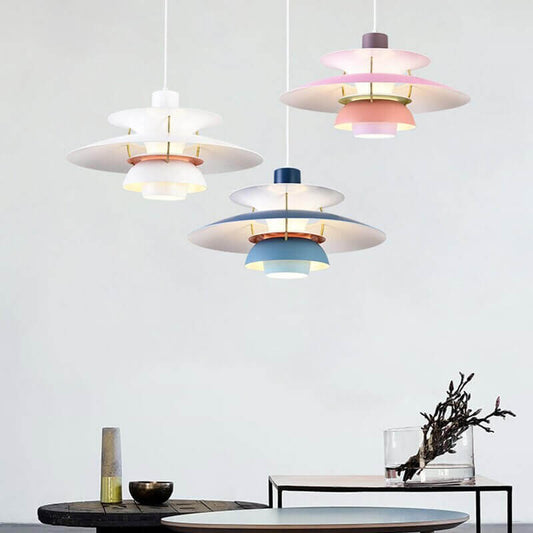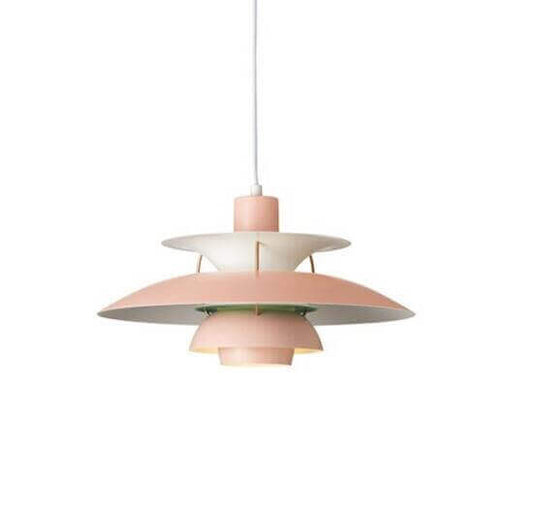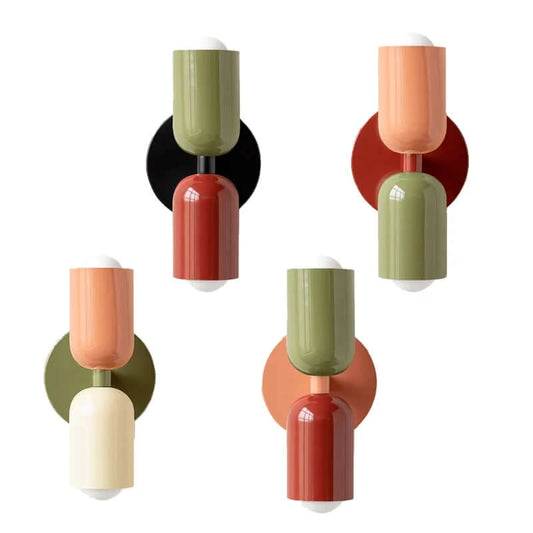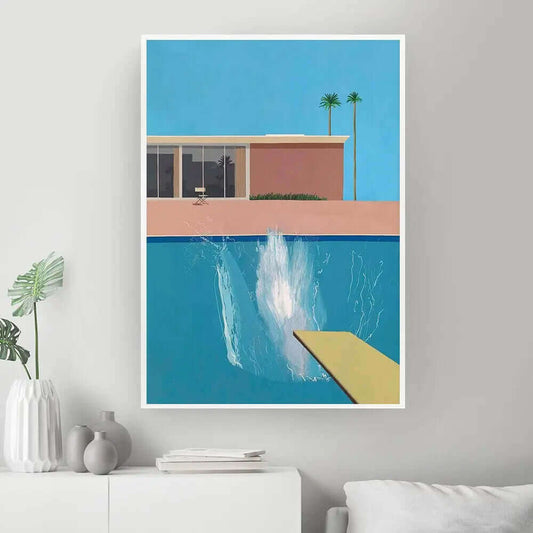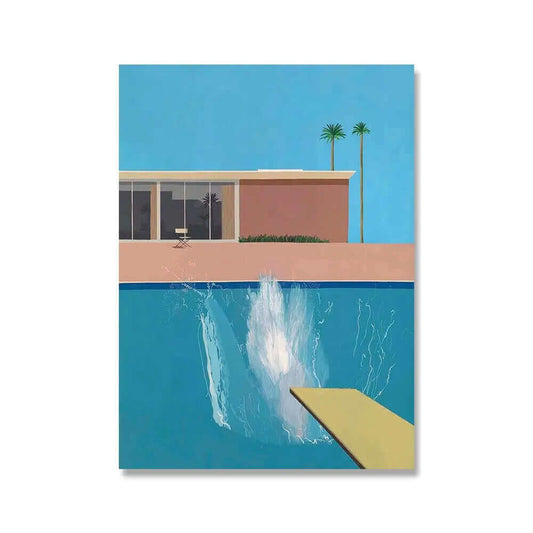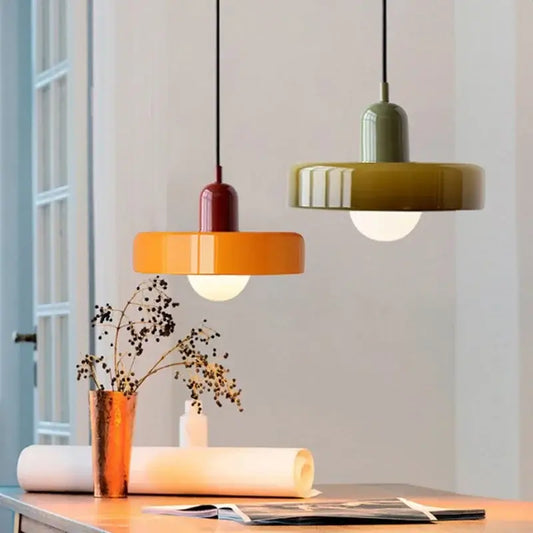-
Pyrex Mug: Pyrex mugs originated from Corning Glass Works in 1915 when they introduced Pyrex, a durable heat-resistant glass suitable for kitchenware. In the mid-20th century, Pyrex coffee mugs gained popularity for their vibrant colors and patterns. The company released various designs, including solid colors, speckled finishes, and charming decals like roosters and fruit motifs. Pyrex mugs became a staple in many households, and vintage collectors now treasure them for their nostalgic appeal and durability.
-
Frankoma Mug: Frankoma Pottery, founded in 1933 by John Frank, produced distinctive coffee mugs with earthy glazes and Native American-inspired designs. Located in Sapulpa, Oklahoma, Frankoma became renowned for its craftsmanship and unique glazing techniques. The company's mugs often featured raised motifs like thunderbirds, buffalo, and Native American symbols. Frankoma mugs from the 1960s and 1970s are highly sought-after by collectors for their timeless beauty and connection to Native American culture.
-
Hornsea Mug: Hornsea Pottery, based in East Yorkshire, England, produced coffee mugs with a sleek and modern aesthetic. Founded in 1949, the company gained popularity in the 1960s and 1970s for its stylish designs and use of stoneware. Hornsea mugs often featured a distinctive "Heirloom" pattern, depicting flowers and foliage in a minimalistic style. The company's innovative designs and high-quality craftsmanship made Hornsea mugs a staple in retro households.
-
Cathrineholm Mug: Cathrineholm, a Norwegian enamelware company founded in the 1820s, gained international recognition in the 1960s for its iconic lotus pattern designed by Grete Prytz Kittelsen. The lotus pattern adorned various kitchenware, including coffee mugs. The company's mugs, often in bright colors like orange and teal, showcased the lotus motif, creating a striking and timeless design. Cathrineholm mugs are now prized collectibles for their mid-century modern appeal and association with Scandinavian design.
-
Typewriter Font Mug: Coffee mugs with typewriter-style fonts became popular during the mid-20th century, especially in the 1950s and 1960s. These mugs featured blocky, monospaced fonts resembling those from vintage typewriters. The typography added a nostalgic touch to coffee mugs and was often used in retro-themed designs for packaging, advertisements, and kitchenware.
-
Arabia Mug: Arabia, a Finnish ceramics company founded in 1873, created a wide range of coffee mugs with Scandinavian-inspired designs. Arabia's mugs featured clean lines, nature motifs, and organic shapes, reflecting the principles of Scandinavian design. The company's most famous mug series is the "Moomin" collection, launched in the 1950s, which features characters from the beloved Moomin books by Tove Jansson.
-
Cobalt Blue Mug: Cobalt blue coffee mugs were prevalent in retro designs, particularly during the mid-20th century. The rich, deep blue color exuded elegance and sophistication, making it a popular choice for kitchenware and table settings. Cobalt blue mugs were often found in fine china or glassware, and their timeless appeal continues to attract collectors today.
-
Fiesta Mug: The Homer Laughlin China Company introduced Fiesta Ware in 1936, featuring a wide array of bold colors and art deco styling. Fiesta mugs were known for their vibrant glazes and iconic ringed designs. The mugs came in a variety of shapes, such as the "Java" mug, which featured a unique handle design. Fiesta Ware remains a popular choice for retro enthusiasts and collectors, with new releases periodically reviving classic colors.
-
Atomic Starburst Mug: Atomic starburst designs gained popularity in the 1950s and 1960s, during the Atomic Age and Space Age era. These mugs featured bursts of lines or rays emanating from a central point, resembling celestial explosions or scientific representations of atoms. The design symbolized the optimism and fascination with scientific progress during that period, making atomic starburst mugs highly sought-after collectibles today.
-
Eames-inspired Mug: The designs of Charles and Ray Eames, famous mid-century modern designers, influenced various products, including coffee mugs. Eames-inspired mugs featured geometric patterns, abstract shapes, and playful color combinations, reflecting the Eames' dedication to functional yet stylish design. Such mugs continue to be popular among fans of mid-century modern aesthetics.
-
Mustard Yellow Mug: Mustard yellow, a warm and retro color, was a prominent hue in mid-century kitchenware and decor. Coffee mugs in this shade exuded a cozy and inviting atmosphere, making them a staple in retro-themed spaces.
-
Wade Heath Mug: Wade Heath Pottery, a British company founded in the 19th century, produced an array of coffee mugs with hand-painted designs. The company was known for its craftsmanship and attention to detail, creating collectible mugs with charming motifs and whimsical illustrations.
-
Space Age Mug: The Space Age, characterized by the Space Race and advancements in space exploration during the 1960s, influenced various designs, including coffee mugs. Space age mugs often featured futuristic elements like rockets, flying saucers, planets, and space helmets. These designs captured the era's enthusiasm for space travel and its impact on popular culture.
-
JAJ Pyrex Mug: J. A. Joblings Ltd., a British company that acquired the Pyrex brand in the 1920s, produced a line of coffee mugs under the name "Pyrex." These mugs often featured charming patterns, such as floral motifs and abstract designs, and were known for their durability and heat-resistant properties.
-
Pastel Pink Mug: Pastel pink mugs were a popular choice for retro kitchens, often associated with the soft and feminine aesthetics of the mid-20th century. The color exuded a sense of elegance and sweetness, making it a favored option for tea and coffee mugs.
-
Beswick Mug: Beswick Pottery, an English company founded in 1894, produced a range of vintage mugs with whimsical animal designs. The company's ceramic mugs often featured hand-painted or molded animal motifs, showcasing Beswick's craftsmanship and creativity.
-
Sunburst Mug: Sunburst motifs, characterized by radiating lines or rays extending from a central point, were a prevalent design element in mid-century decor. Coffee mugs with sunburst designs represented the era's enthusiasm for space exploration and atomic science.
-
Ruscha Mug: Ruscha, a German pottery company founded in 1948, produced a variety of coffee mugs with abstract designs and bold colors. The company's innovative glazing techniques and artistic designs made Ruscha mugs stand out in the retro pottery market.
-
Ceramic Molded Handle Mug: Coffee mugs with unique molded handles became popular during the mid-century era. These handles were often shaped like animals, people, or objects, adding a touch of whimsy and charm to the mugs.
-
Teal Green Mug: Teal green mugs, with their refreshing and vibrant color, were a popular choice in retro kitchenware. The hue reflected the era's fascination with tropical and aquatic themes.
-
Melamine Mug: Melamine resin, a durable and lightweight plastic, was commonly used in retro picnicware and camping gear, including coffee mugs. Melamine mugs were prized for their resistance to breakage and suitability for outdoor use.
-
Crown Lynn Mug: Crown Lynn Potteries, a New Zealand-based company founded in 1854, produced a range of coffee mugs with timeless and minimalist designs. The company's mugs were characterized by their clean lines, solid colors, and understated elegance.
-
Harlequin Mug: The Harlequin collection from Homer Laughlin China Company featured a series of coffee mugs, each showcasing a different solid color from the Harlequin range. Released in the 1930s and 1940s, these mugs added a playful and colorful touch to retro table settings.
-
Pantone-inspired Mug: Pantone, a color-matching system introduced in the 1960s, inspired coffee mugs featuring classic Pantone color swatches. These mugs celebrated the beauty of individual colors and were popular among designers and color enthusiasts.
-
Bold Floral Mug: Bold floral patterns were a staple in retro home decor, and coffee mugs adorned with large and vibrant flowers exemplified this trend. Such mugs brought a touch of nature indoors and added visual interest to kitchenware.
-
Syracuse China Mug: Syracuse China Corporation, founded in 1871, was known for producing high-quality hotel and restaurant-grade ware, including coffee mugs. The company's mugs featured classic designs and sturdy construction, making them a popular choice for commercial use.
-
Copper-Tone Mug: Copper-tone mugs featured a metallic finish reminiscent of vintage copper kitchenware. The lustrous appearance exuded elegance and sophistication, making these mugs an attractive addition to retro table settings.
-
Red Wing Pottery Mug: Red Wing Pottery, founded in 1878 in Minnesota, produced coffee mugs with rustic designs and earthy tones. The company's mugs often featured hand-painted motifs and reflected the charm of the American Midwest.
-
Daisy Chain Mug: Coffee mugs with daisy chain patterns or repetitive floral designs captured the essence of retro folk art and added a touch of whimsy to table settings.
-
Milk Glass Mug: Milk glass, a type of opaque or translucent glass, was commonly used in retro coffee mugs. Mugs made from milk glass often featured simple patterns or colorful decals, showcasing the versatility of this material in kitchenware design.
-
Mod Target Mug: The mod target symbol, a prominent design element in the mod subculture of the 1960s, graced coffee mugs during the retro era. This distinctive design exemplified the era's youth-oriented fashion and music movements.
-
Burnt Orange Mug: Burnt orange coffee mugs added a warm and cozy touch to retro kitchens and table settings. The earthy color was popular during the mid-20th century and evoked a sense of comfort and nostalgia.
-
Bakelite Handle Mug: Coffee mugs with handles made from Bakelite, a vintage plastic known for its durability and distinctive appearance, were commonly used in retro kitchenware. The Bakelite handles added a touch of retro charm to coffee mugs.
-
Blue Willow Mug: Blue Willow, a classic and enduring Chinese porcelain pattern, inspired various coffee mugs during the retro era. The design featured a romantic narrative with scenes of pagodas, bridges, and birds, and it has remained a beloved and timeless motif in tableware.
-
Marimekko Mug: Marimekko, a Finnish design company founded in 1951, gained international recognition for its bold and colorful prints. Marimekko coffee mugs featured the company's iconic designs, reflecting the optimism and vibrant spirit of the mid-century era.
-
Gingham Mug: Coffee mugs featuring gingham check patterns reflected the retro kitchen textiles popular during the mid-20th century. The gingham motif added a touch of nostalgia and country charm to coffee mugs.
-
Fire-King Jadite Mug: Fire-King, a line of glassware produced by Anchor Hocking Glass Corporation, included coffee mugs in a distinctive Jadite green color. The glassware's glossy finish and bright green hue made it a favorite among retro collectors and enthusiasts.
-
Filigree Mug: Filigree coffee mugs featured intricate designs, often inspired by filigree jewelry and metalwork. The delicate patterns added elegance and sophistication to retro table settings.
-
Op Art Mug: Op Art, a mid-century art movement, inspired coffee mugs with optical illusion designs. These mugs featured abstract patterns that created visual effects, engaging the viewer's perception.
-
Yellowware Mug: Yellowware, a type of pottery with a yellow glaze, gained popularity in the mid-19th century and remained a cherished material for retro coffee mugs. These mugs often featured simple and charming designs that captured the essence of a bygone era.
-
Palm Springs Mug: Coffee mugs inspired by the mid-century modern architecture and lifestyle of Palm Springs, California, featured vibrant colors and sleek designs. The mugs represented the exuberant and glamorous atmosphere of the desert oasis during the retro era.
-
Iittala Mug: Iittala, a Finnish design company founded in 1881, produced coffee mugs with minimalist and timeless designs. The company's mugs often featured clean lines and functional shapes, reflecting the Scandinavian principles of simplicity and functionality.
-
Polychrome Mug: Polychrome coffee mugs featured multiple colors in their designs, adding vibrancy and liveliness to retro table settings. These mugs were often decorated with hand-painted or transfer-printed motifs, showcasing the craftsmanship of the era.
-
Aqua Blue Mug: Aqua blue coffee mugs, reminiscent of refreshing coastal waters, were popular choices for retro beach-themed decor. The color added a sense of tranquility and relaxation to coffee breaks.
-
Sgraffito Mug: Sgraffito, a pottery decoration technique, involved scratching off the top layer of glaze to reveal the underlying clay or glaze color. Coffee mugs with sgraffito designs showcased the skill and artistry of potters and added unique textures to retro tableware.
-
Geometric Mug: Coffee mugs with bold geometric patterns reflected the influence of retro art and design movements like Art Deco and Bauhaus. Geometric designs added a sense of sophistication and modernity to coffee mugs.
-
Roseville Pottery Mug: Roseville Pottery, a renowned American pottery company founded in 1892, produced coffee mugs with hand-crafted designs and earthy tones. The company's mugs often featured intricate motifs inspired by nature, showcasing the artistry of American potters.
-
Tricorn Black Mug: Tricorn black coffee mugs featured a glossy black glaze, creating a sophisticated and timeless appearance. These mugs added a touch of elegance and drama to retro table settings.
-
Polka Dot Mug: Polka dot patterns, characterized by round dots arranged in a regular pattern, were a popular design element in retro kitchenware. Coffee mugs adorned with polka dots added a playful and charming touch to coffee breaks.
-
Chrome Trim Mug: Coffee mugs with a metallic chrome trim were reminiscent of retro diner-style coffee mugs. The chrome accents added a touch of retro glamour and sophistication to coffee mugs.





